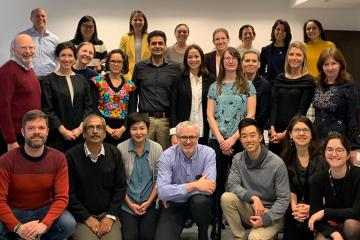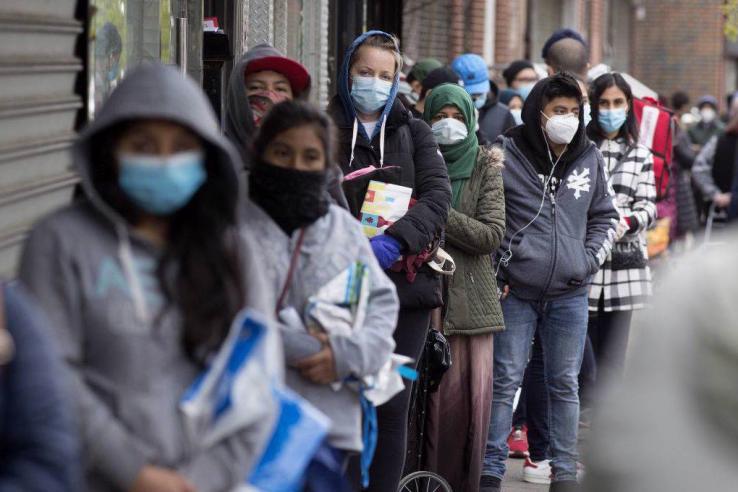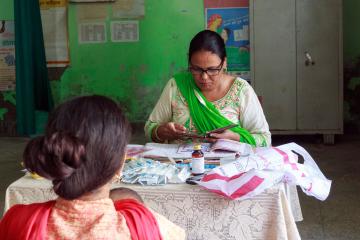
Growth is not enough

This op-ed was originally published in Project Syndicate.
Following the steep economic downturns brought about by COVID-19, policymakers should be asking or rethinking fundamental questions. None is more fundamental than whether rapid economic growth is the best way to drive development and help struggling communities escape poverty.
For good reason, economic growth has long been a top policy goal for countries around the world. But for millions of people living in poverty, growth is not enough. Specific, targeted social programs based on rigorous empirical evidence are equally important to prevent people from being left behind.
Fortunately, America’s new president, Joe Biden, seems to grasp this. Seeking to restore public trust in the US government, he has declared it “the policy of my Administration to make evidence-based decisions guided by the best available science and data,” including randomized control trials (RCTs). The challenge now will be to strike a balance between the persistent demand for robust growth and the need for broader economic and social inclusion.
In this respect, America is hardly unique. China’s GDP has grown by about 10 percent per year since 1978, lifting more than 850 million people out of poverty. And yet, according to the World Bank, 373 million Chinese remain “below the upper-middle-income poverty line of $5.50 a day,” and must reckon with food insecurity, joblessness, and lack of access to public services.
Similarly, India is now the world’s fifth-largest economy, yet tens of millions of its people still live in extreme poverty. Even in the United States, the world’s largest economy for the past century, 34 million people were living below the federal poverty line before the COVID-19 pandemic struck, with more than ten million food-insecure households and more than a half-million people experiencing homelessness on any given night.
Of course, it is important to remember that poverty is an inherently relative concept. There will always be people who are much less economically or materially prosperous than others, and to live in poverty will always mean something drastically different in some contexts than it does in others. For this reason, the definition of poverty must remain somewhat flexible, especially as regional trends in economic growth shift.
Nonetheless, the pandemic has brought jarring images of long lines for food and other critical supplies even in the US. We have been reminded that for vulnerable communities, the specter of poverty is always looming.
Other pieces of the puzzle
In recent decades, research has shed light on some of the reasons why poverty and its associated challenges (low education outcomes, poor health) persist even in rich countries and those experiencing rapid economic growth.
Consider the goal of universal, high-quality education, which is recognized as fundamental to achieving sustained economic growth and reducing overall poverty and inequality. Economic growth often spurs investment in education systems: construction of new schools, training and hiring of teachers, and purchases of school equipment and materials such as textbooks and laptops. But if the curriculum and pedagogy are not designed well, it does not matter if children have desks, textbooks, or computers: many students still will not master basic literacy and numeracy skills by the time they leave primary school.
In fact, although school enrollment has shot up dramatically in low- and middle-income countries over the past several decades, learning outcomes have been far more varied. For example, India’s 2018 Annual Status of Education Report found that only about half of fifth-grade students in rural schools could read a second-grade text, and assessments in many other countries showed similar results.
Even in a resource-rich country such as the US, learning outcomes are lower than they should be. On a national math exam in 2017, 30 percent of US eighth graders scored below a basic proficiency level, and that number has been increasing over the past decade.
Over the past 15 years, several researchers—including 2019’s Nobel laureates in economics, Abhijit Banerjee, Esther Duflo, and Michael Kremer—have conducted a series of RCTs showing that school materials such as textbooks do not directly lead to better learning outcomes for students. But they have also identified an intervention that absolutely does deliver results: an innovative pedagogical approach called Teaching at the Right Level (TaRL), which was pioneered by Pratham, a nongovernmental education organization in India.
TaRL emphasizes instruction at children’s current learning ability, rather than according to their age or their grade level, and it does not require expensive materials or technology. In fact, its main assessment tool can be created in a few minutes on a sheet of paper, and many of its activities are typically completed with students and teachers sitting on a classroom floor. Despite their low cost and simplicity, TaRL programs have proven to be very effective at improving learning outcomes in many countries. And a similar model of targeted instruction is now being implemented in the US, with positive results for students in Chicago and New York City.
The health of nations
Similarly, economic growth allows for the construction of new health centers, hiring of more health workers, and greater investment in the latest medical technology, all of which is necessary for providing high-quality care to the population. But creating a reliable supply is not enough; there also must be demand for health services, which does not follow automatically from economic growth.
For example, even if health centers are open and well stocked with vaccines, parents might not bring their children to be immunized, either because they do not believe that vaccines are important or safe, or because they are deterred by the difficulty of traveling to the health center. Once again, RCTs in India found that while investing in the vaccine supply chain led to a 12-percentage-point increase in immunization, adding an incentive as small as a bag of lentils for each visit increased full immunization rates by an additional 21 percentage points. This suggests that what parents needed was not just better infrastructure but also a (relatively small) nudge to overcome the cost in time and money of bringing their children to a clinic.
Again, the same issues crop up in high-income economies. In the US, public-health officials are currently trying to convince Americans, particularly among the most vulnerable socioeconomic groups, to seek out the new COVID-19 vaccines. While the US also must worry about supply-chain issues, these at least can be resolved through resource investment and better logistics. But addressing public skepticism about vaccines requires additional interventions.
As these examples show, neither economic growth nor a country’s wealth is the sole decisive factor in tackling intransigent social problems such as poverty. Additional insights into human behavioral patterns and rigorous, scientific evaluation are also needed to craft effective programs and maximize the desired results.
Well-designed RCTs can provide policymakers and funders with evidence directly from the field to show which targeted programs work, and why. With these insights in hand, policymakers can avoid relying on instincts, ideology, or inertia when making major investment decisions. Otherwise, they risk pouring funds into feel-good programs that don’t actually deliver.
Paradoxes of progress
Some problems that contribute to poverty are a byproduct of economic growth itself. Growth increases consumption of energy, natural resources, and goods, boosts carbon emissions and pollution, and places a greater overall strain on the environment. All of these factors are contributing to climate change, which threatens to exacerbate poverty among the most vulnerable communities in both developed and developing countries. And because economic growth does not automatically solve the problems it creates, targeted interventions are needed.
Here, too, RCTs have helped identify evidence-based policy innovations and programs that can reduce the negative environmental effects of growth. In the case of industrialization, which often leads to higher incomes or more jobs, but also to more pollution, regulators need to know which plants are polluting the most, and thus might rely on factory auditing.
The problem is that in many countries, auditors are managed and paid by the companies they are auditing, creating a clear conflict of interest. Hence, researchers who studied this problem in the Indian state of Gujarat found that when auditors were randomly assigned to plants, paid from a common pool, monitored for accuracy, and awarded a bonus for accurate reports, plants decreased their harmful emissions by 28 percent. Evidence from this RCT was essential in helping the government tackle a problem that rapid economic growth had created.
Similarly, by creating winners and losers, economic growth and globalization often increase inequality, which can lead to significant sociopolitical upheavals, even in the richest countries, as we have seen recently in France and the US. Policymakers often respond to this problem by creating social-welfare programs such as targeted basic income. But while economic growth and a high GDP can help pay for such programs, fundamental questions remain, such as how much income to transfer, who should receive it, and how redistribution can be carried out most effectively.
These are small but crucial issues that bear directly on whether a program achieves its desired results, or simply adds another level of waste. In Indonesia, an RCT found that a community block grant program called Generasi was effective at improving health and education outcomes at the village level, and these outcomes were enhanced by the addition of performance incentives. Following its demonstrated successes, Generasi was scaled up in 2010, and has since reached almost five million people. Once again, evidence-based policymaking can be the difference between success and failure.
No app for that
Perfecting the details of such programs can seem like a tedious distraction. Shouldn’t policymakers be focusing on the bigger questions of how to create more growth? In fact, as the aforementioned examples show, questions about the design of an intervention aren’t so “small” after all. Not only are they vital for a program’s success, but they can also help programs reach a significant scale. Programs evaluated through RCTs just by researchers affiliated with our organization, J-PAL, have now reached more than 400 million people around the world.
More broadly, it is easy to fall into the one-size-fits-all trap when seeking solutions to poverty. Economic growth isn’t the only force that is often seen as a panacea. So is technology, which is often hyped as a revolutionary, across-the-board solution for communities living in poverty. As we have seen in education, introducing technology doesn’t always solve the problem, and sometimes even creates new problems. Policymakers often forget that technology is merely a means, not an end in itself.
For example, reducing absenteeism among health-care workers has been a major challenge in the Indian state of Karnataka, leading it to deploy a biometric monitoring system to record doctors’ attendance in primary health centers. But when the system was evaluated, researchers found that although the technology itself was sound—monitors recorded and uploaded real-time, accurate attendance data—the government still was unable to enforce attendance incentives and penalties. It therefore decided not to scale up the program, saving millions of dollars and countless hours of staff time.
Similarly, in Odisha, India, researchers evaluated the benefits of a commonly used cook stove that had been shown in laboratory tests to reduce dangerous indoor air pollution and require less fuel. They found that the stoves had no impact on smoke exposure or long-term health, pointing to a crucial difference between laboratory and real-world results. The issue was not that the technology was faulty or the original measurements incorrect; it was that most people did not use the stoves regularly or appropriately, and did not maintain them properly. Again, for all of the attractions of the new technology, underlying behavioral and contextual factors turned out to have a stronger influence on overall effectiveness.
It takes an empirical village
No one doubts that technological innovation and economic growth have a vital role to play in reducing poverty for millions of people around the world. The problem lies in assuming that these factors are sufficient. Recognizing the real-world limitations, even governments in the world’s richest or fastest-growing countries have begun to assign departments to design and implement targeted programs to improve livelihoods and ensure better health, education, and environmental outcomes. Relying solely on a finance or commerce department, or on a well-functioning central bank, is not enough to alleviate poverty.
The same principle applies to NGOs and other organizations that design and deliver programs in agriculture, crime prevention, gender relations, and governance. Together, these initiatives can provide multifaceted perspectives on overcoming poverty—but demonstrated effectiveness is key.
Just because a program is targeted doesn’t mean it will succeed. There will always be failures, and the difference lies in using rigorous field research such as RCTs to design the most innovative ideas based on the best available evidence. Piloting and evaluating programs with the help of strong monitoring systems is necessary for achieving the desired scale.
Together, economic growth and policies informed by RCTs can help tackle problems such as poverty, inequality, and climate change. Even in countries that are not experiencing GDP growth because of other insurmountable constraints (such as a pandemic), improving the design and delivery of social and economic programs can make a significant difference in people’s lives.
Evidence-based knowledge is power. To ensure that no one is left behind, governments, NGOs, researchers, and donors must come together to generate more of it.



